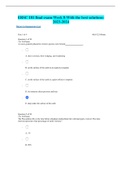Ersc 181 week 8 final - Study guides, Class notes & Summaries
Looking for the best study guides, study notes and summaries about Ersc 181 week 8 final? On this page you'll find 28 study documents about Ersc 181 week 8 final.
Page 2 out of 28 results
Sort by
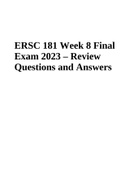
-
ERSC 181 Week 8 Final Exam 2023 – Review Questions and Answers
- Exam (elaborations) • 15 pages • 2023
- Available in package deal
-
- $14.49
- + learn more
ERSC 181 Week 8 Final Exam 2023 – Review Questions and Answers. Pyroclastic flows are more associated with __________. ocean hot spots stratovolcanoes shield volcanoes flood basalts cinder cones Question 2 2/2 points In the rock cycle, what processes directly link igneous rocks to metamorphic rocks? compaction and cementation melting and crystallization deposition and lithification recrystallization by high heat and pressure weathering and erosion Question 3 2/2 points The prima...
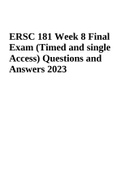
-
ERSC 181 Week 8 Final Exam (Timed and single Access) Questions and Answers 2023
- Exam (elaborations) • 17 pages • 2023
- Available in package deal
-
- $16.49
- + learn more
ERSC 181 Week 8 Final Exam (Timed and single Access) Questions and Answers 2023. The primary basis for classifying detrital (clastic) rocks is _______, whereas the primary basis for classifying chemical rocks is ________. Question 6 2 / 2 points The Precambrian Era is the time before abundant multicellular life with hard parts evolved. This time interval represents what percentage of earth's history? Question 7 2 / 2 points Which of the following surficial processes results in the most po...
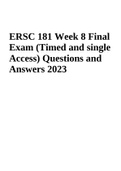
-
ERSC 181 Week 8 Final Exam Questions and Answers 2023 Complete Rated A+ | ERSC 181 WEEK 8 Exam Questions and Answers 2023 | ERSC 181 Week 8 Final Exam (Timed and single Access) Questions and Answers 2023 & ERSC 181 Week 8 Final Exam 2023 – Review Question
- Package deal • 4 items • 2023
-
- $32.49
- + learn more
ERSC 181 Week 8 Final Exam Questions and Answers 2023 Complete Rated A+ | ERSC 181 WEEK 8 Exam Questions and Answers 2023 | ERSC 181 Week 8 Final Exam (Timed and single Access) Questions and Answers 2023 & ERSC 181 Week 8 Final Exam 2023 – Review Questions and Answers
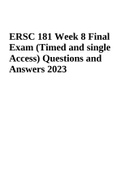
-
ERSC 181 Week 8 Final Exam 2023 – Review Questions and Answers | ERSC 181 Week 8 Final Exam Questions and Answers 2023 Complete Rated A | ERSC 181 WEEK 8 Exam Questions and Answers 2023 – all Correct & ERSC 181 Week 8 Final Exam (Timed and single Access)
- Package deal • 4 items • 2023
-
- $45.49
- + learn more
ERSC 181 Week 8 Final Exam 2023 – Review Questions and Answers | ERSC 181 Week 8 Final Exam Questions and Answers 2023 Complete Rated A | ERSC 181 WEEK 8 Exam Questions and Answers 2023 – all Correct & ERSC 181 Week 8 Final Exam (Timed and single Access) Questions and Answers 2023
ERSC 181 final exam-Week 8-With 100% verified solutions-2023-2024
ERSC 181 final exam-Week 8-With the best solutions-2023-2024
QUESTIONS AND ANSWERS
QUESTIONS AND ANSWERS
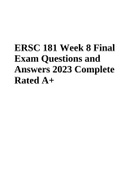
-
ERSC 181 Week 8 Final Exam Questions and Answers 2023 Complete Rated A+
- Exam (elaborations) • 42 pages • 2023
- Available in package deal
-
- $15.49
- + learn more
ERSC 181 Week 8 Final Exam Questions and Answers 2023 Complete Rated A+. When going from a magnitude 5 to a magnitude 6 earthquake on the Richter magnitude scale, what is the increase in seismic wave amplitude? A. 100 B. 2 C. 0.5 D. 10 E. 1 Week 8 Final Exa Question 2 of 50 2.0/ 2.0 Points Which of the following surficial processes results in the most poorly sorted sediments? A. wind B. rivers C. deep marine D. glaciers E. ocean w...
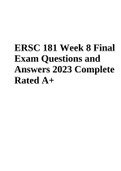
-
ERSC 181 Week 8 Final Exam Questions and Answers 2023 Complete Rated A+
- Exam (elaborations) • 42 pages • 2023
- Available in package deal
-
- $16.49
- + learn more
ERSC 181 Week 8 Final Exam Questions and Answers 2023 Complete Rated A+. Applying the principles of relative age-dating to the diagram, which of the following is TRUE. Explanation of the diagram: "A" represents an unconformity (erosional surface), "B" is a basaltic dike, "C" is a shale formation, "D" is a sandstone formation, "E" is a limestone formation, "F" represents a thrust fault. A. A is YOUNGER than C B. F is YOUNGER than A C. E is OLDER than B D...

How much did you already spend on Stuvia? Imagine there are plenty more of you out there paying for study notes, but this time YOU are the seller. Ka-ching! Discover all about earning on Stuvia




